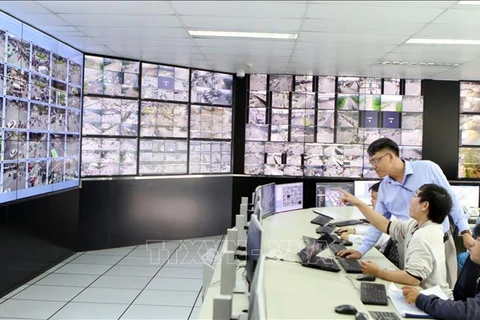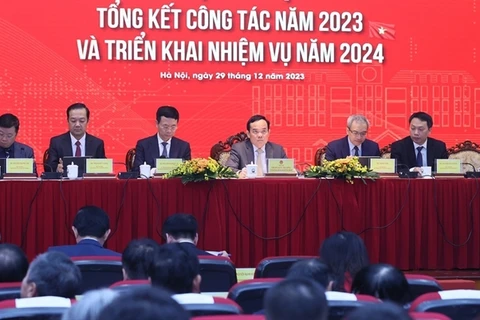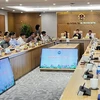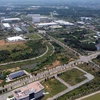Hanoi (VNS/VNA) - Comprehensive plans are in place to rejuvenate and advance Vietnam's information and communications infrastructure.
The Ministry of Information and Communications has announced details of the information and communications infrastructure planning project for the period of 2021-2030, with a visionary outlook extending to 2050, which was recently approved by Prime Minister Pham Minh Chinh.
This planning project outlines Vietnam's ambitious objectives to establish the groundwork for a digital government, foster a thriving digital economy and cultivate a connected digital society.
The envisioned information and communications infrastructure encompasses a cohesive framework that integrates various components, including the postal network, digital infrastructure, information technology industrial infrastructure, national digital transformation platforms and security assurance systems. This interconnected network is pivotal for ensuring the integrity and security of all information within the system.
Digital infrastructure
The plan aims for significant advancements in digital infrastructure by 2025. It envisions ubiquitous access to fiber optic cable for households, ensuring that 100% have access when needed.
It sets goals for smartphone ownership among the adult population, access to high-speed Internet for technological hubs and government agencies, integration of IoT in essential infrastructure and the adoption of cloud computing services by Vietnamese businesses.
Simultaneously, the plan entails deploying and investing in two to four additional international telecommunications cable lines. It also outlines the establishment and deployment of national data centres, including at least three national multi-purpose data centre clusters, regional multi-purpose data centre clusters, and one or two regional data centres catering to the needs of financial centres in Vietnam, the region, and internationally.
Looking ahead to 2030, the focus shifts towards substantial improvements in fixed broadband access network infrastructure. Additionally, the plan aims to extend the coverage of 5G mobile broadband networks to 99% of the population, with an emphasis on advancing next-generation mobile networks.
Furthermore, the target is set for 100% of state agencies, state-owned enterprises, and over 50% of the population to utilise cloud computing services provided by domestic enterprises.
To support these initiatives sustainably, the plan calls for the development of large-scale data centre clusters adhering to green standards.
By 2030, the completion and seamless operation of national-scale digital platforms will be prioritised to meet the demands of the digital government, digital economy, and digital society. The objective is to ensure universal access to and utilisation of advanced digital services of high quality at reasonable prices for all individuals.
In terms of network information security, aiming for robust safeguards across digital government, digital economy, and digital society domains, the target by 2025 is to achieve comprehensive security coverage. This entails ensuring that 100% of information systems within state agencies are fortified at the system level, with adherence to the four-layer model for network information security by all ministries, ministerial-level agencies, and provincial People's Committees.
Additionally, all terminal devices within state agencies are slated to be equipped with solutions to guarantee network information security. Furthermore, efforts will be directed towards enhancing public awareness and equipping internet users with access to information, educational materials, skills, and fundamental cyber information security services. Each agency, organisation, and business is expected to have at least one dedicated unit specialising in network information security, while every individual will possess at least one tool to safeguard network information security.
The planning scheme also aims to establish a comprehensive cyber information security product ecosystem, encompassing 100 % of its categories, with the development of three to five key information security products and services. These products are intended to not only dominate the domestic market but also compete globally.
By 2030, Vietnam seeks to emerge as a prominent hub in Asia for ensuring network information security and network security. The goal is to shape a market renowned for its competitiveness and influence across the region and beyond. Vietnamese digital technology enterprises are encouraged to leverage open-source technologies to attain technological autonomy, thereby mastering the Vietnamese network information security and network security market.
This strategic direction underscores Vietnam's commitment to becoming a powerhouse in cyberspace security, safeguarding national cyberspace sovereignty, ensuring information security, and preserving social order and safety.
In line with advancing the information technology industry, plans are in place to formulate and implement schemes and projects for 12-14 concentrated information technology parks and members of the software park chain by 2025.
By 2030, the aim is to expand this to 16-20 concentrated information technology parks and members of the software park chain. The development of Vietnam's digital technology industry is envisioned with a focus on merging self-reliance with international cooperation. This entails activities such as design, integration, technology mastery, and technology creation, targeting not only the Vietnamese market but also the global arena.
Solutions
The planning project introduces several key solutions, including some innovative approaches.
These include phasing out old-generation mobile telecommunications technology in favour of newer technologies, reallocating frequency bands to develop advanced 4G, 5G, and future generations of mobile networks.
The planning scheme also recommends prioritising the development of the 5th generation (5G) mobile information network starting from 2025, with the allocation of telecommunications resources based on market mechanisms to ensure service quality on par with global standards.
The Government will also work to allow data centres to procure electricity directly from the source, enabling regional data centres (Digital Hubs) to implement specific mechanisms, with preference given to locations within regional financial centres and international government hubs.
Establishing key laboratories to develop essential "Make in Vietnam" products tailored for digital government, digital economy, digital society, digital transformation, smart production, and smart agriculture is also included./.
The Ministry of Information and Communications has announced details of the information and communications infrastructure planning project for the period of 2021-2030, with a visionary outlook extending to 2050, which was recently approved by Prime Minister Pham Minh Chinh.
This planning project outlines Vietnam's ambitious objectives to establish the groundwork for a digital government, foster a thriving digital economy and cultivate a connected digital society.
The envisioned information and communications infrastructure encompasses a cohesive framework that integrates various components, including the postal network, digital infrastructure, information technology industrial infrastructure, national digital transformation platforms and security assurance systems. This interconnected network is pivotal for ensuring the integrity and security of all information within the system.
Digital infrastructure
The plan aims for significant advancements in digital infrastructure by 2025. It envisions ubiquitous access to fiber optic cable for households, ensuring that 100% have access when needed.
It sets goals for smartphone ownership among the adult population, access to high-speed Internet for technological hubs and government agencies, integration of IoT in essential infrastructure and the adoption of cloud computing services by Vietnamese businesses.
Simultaneously, the plan entails deploying and investing in two to four additional international telecommunications cable lines. It also outlines the establishment and deployment of national data centres, including at least three national multi-purpose data centre clusters, regional multi-purpose data centre clusters, and one or two regional data centres catering to the needs of financial centres in Vietnam, the region, and internationally.
Looking ahead to 2030, the focus shifts towards substantial improvements in fixed broadband access network infrastructure. Additionally, the plan aims to extend the coverage of 5G mobile broadband networks to 99% of the population, with an emphasis on advancing next-generation mobile networks.
Furthermore, the target is set for 100% of state agencies, state-owned enterprises, and over 50% of the population to utilise cloud computing services provided by domestic enterprises.
To support these initiatives sustainably, the plan calls for the development of large-scale data centre clusters adhering to green standards.
By 2030, the completion and seamless operation of national-scale digital platforms will be prioritised to meet the demands of the digital government, digital economy, and digital society. The objective is to ensure universal access to and utilisation of advanced digital services of high quality at reasonable prices for all individuals.
In terms of network information security, aiming for robust safeguards across digital government, digital economy, and digital society domains, the target by 2025 is to achieve comprehensive security coverage. This entails ensuring that 100% of information systems within state agencies are fortified at the system level, with adherence to the four-layer model for network information security by all ministries, ministerial-level agencies, and provincial People's Committees.
Additionally, all terminal devices within state agencies are slated to be equipped with solutions to guarantee network information security. Furthermore, efforts will be directed towards enhancing public awareness and equipping internet users with access to information, educational materials, skills, and fundamental cyber information security services. Each agency, organisation, and business is expected to have at least one dedicated unit specialising in network information security, while every individual will possess at least one tool to safeguard network information security.
The planning scheme also aims to establish a comprehensive cyber information security product ecosystem, encompassing 100 % of its categories, with the development of three to five key information security products and services. These products are intended to not only dominate the domestic market but also compete globally.
By 2030, Vietnam seeks to emerge as a prominent hub in Asia for ensuring network information security and network security. The goal is to shape a market renowned for its competitiveness and influence across the region and beyond. Vietnamese digital technology enterprises are encouraged to leverage open-source technologies to attain technological autonomy, thereby mastering the Vietnamese network information security and network security market.
This strategic direction underscores Vietnam's commitment to becoming a powerhouse in cyberspace security, safeguarding national cyberspace sovereignty, ensuring information security, and preserving social order and safety.
In line with advancing the information technology industry, plans are in place to formulate and implement schemes and projects for 12-14 concentrated information technology parks and members of the software park chain by 2025.
By 2030, the aim is to expand this to 16-20 concentrated information technology parks and members of the software park chain. The development of Vietnam's digital technology industry is envisioned with a focus on merging self-reliance with international cooperation. This entails activities such as design, integration, technology mastery, and technology creation, targeting not only the Vietnamese market but also the global arena.
Solutions
The planning project introduces several key solutions, including some innovative approaches.
These include phasing out old-generation mobile telecommunications technology in favour of newer technologies, reallocating frequency bands to develop advanced 4G, 5G, and future generations of mobile networks.
The planning scheme also recommends prioritising the development of the 5th generation (5G) mobile information network starting from 2025, with the allocation of telecommunications resources based on market mechanisms to ensure service quality on par with global standards.
The Government will also work to allow data centres to procure electricity directly from the source, enabling regional data centres (Digital Hubs) to implement specific mechanisms, with preference given to locations within regional financial centres and international government hubs.
Establishing key laboratories to develop essential "Make in Vietnam" products tailored for digital government, digital economy, digital society, digital transformation, smart production, and smart agriculture is also included./.
VNA
























